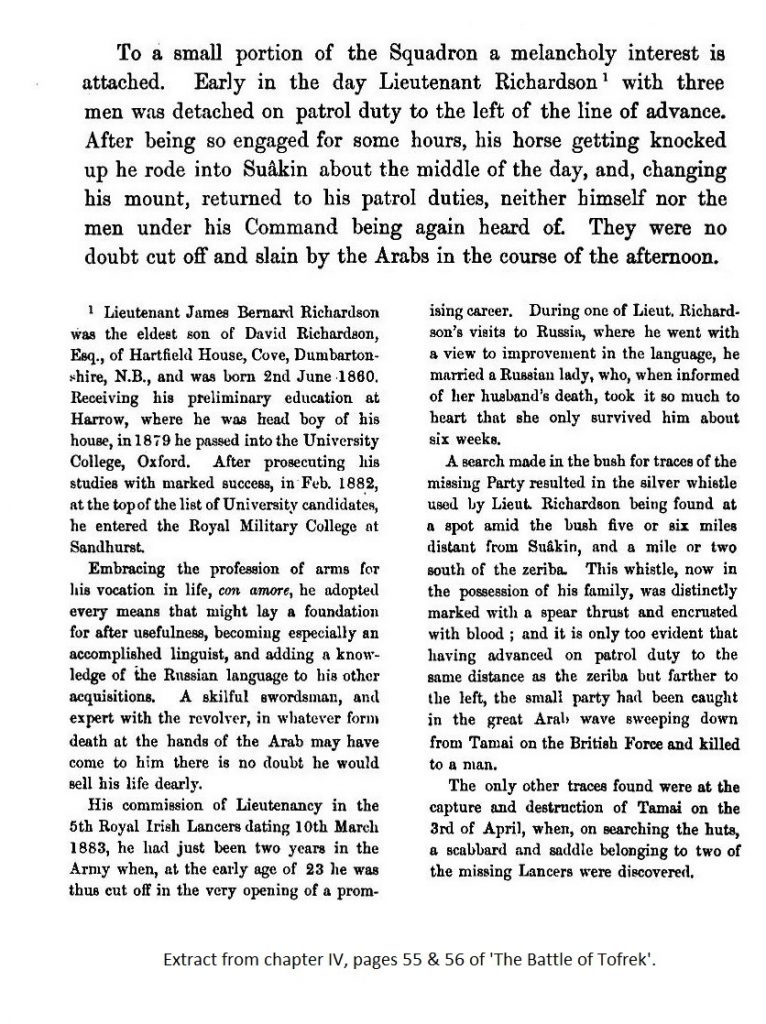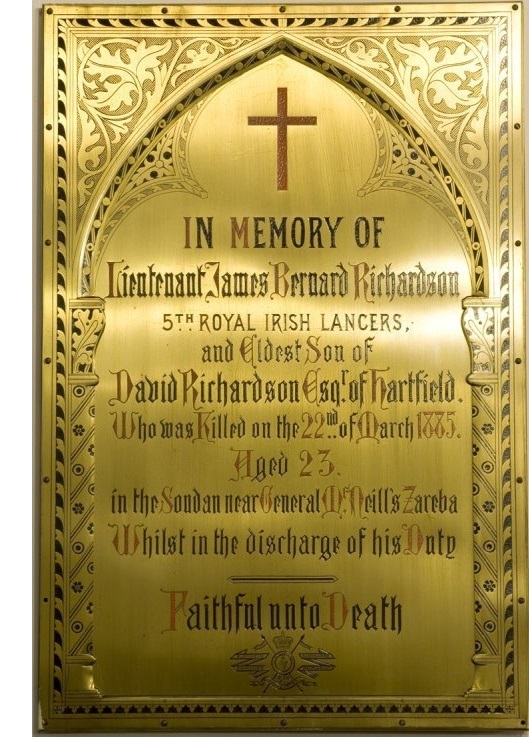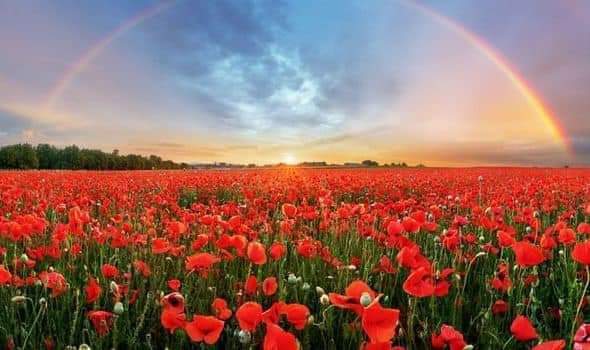
The Remembrance Memorial in St. Modan’s Parish Church Rosneath, has the names of Sixteen men who died during World War I, and three men who died during World War II. The following pages contain records of those Nineteen men, who are recorded on that memorial.
To date, there has been difficulty in tracing details of two of the men who died in World War I and two men who died in World War II. Details of those Men are included with an expectation to later provide detail.
Please note there are also a few name ‘differences’ between what is detailed on the memorial and other sources. These are explained in the details of those men and their sacrifice below.
If readers have any addition information of recommendations they would like to add, or delete, please feel free to contact Tony Belk or this site and discuss.
Tony Belk 2019-2024
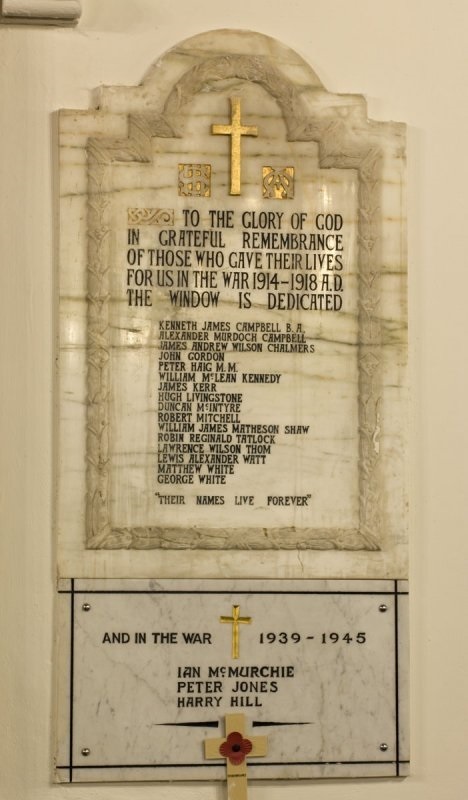
Rosneath and Clynder – Roll of Honour
Click on Blue link to navigate to section
WW1
Campbell. Alexander Murdoch
Campbell. Kenneth James
Chalmers. James Andrew Wilson
Gordon. John
Haig. Peter
Kennedy. William McLean
Kerr. James
Livingstone. Hugh
MacIntyre. Duncan
Mitchell. Robert
Shaw. William James Matheson
Tatlock. Robin Reginald
Thom. Lawrence Wilson
Watt. Lewis Alexander
White. George
White. Matthew
WW2
Hill. Harry
Jones. Peter
McMurchie. Ian
McMurchie. John Welsh
There are also a number of other Rosneath ‘Fallen’ that are included in these pages. These are included alongside the list above for completeness and respect, of those that “They gave their today for our tomorrow”, regardless of which conflict. These are: –
- Edward Morrison (Smith) 1st Battalion Gordon Highlanders died 27th Feb. 1901at H.R.H. Princess Louise Hospital Home, Rosneath, died from his injuries after the 1889-1902 Second Boar War .
- John Clarke, listed in the old churchyard on the grave William Nelson Clarke. On the rear (West) side of the stone is a memorial to John his son who died during the 1878 – 1879 Anglo-Zulu War war.
- James Bernard Richardson, listed on the memorial plaque in St. Modan’s Church, who died at the Battle of Tofrek, Sudan, during the 1884 – 1885 Mahdist (Sudanese) War
Old Rosneath Parish Cemetery
Sadly, many families where not able to bring their loved one’s home. Only on a few occasions are the those that died in conflict or the aftermath able to be buried in the old Rosneath Cemetery. There is at least one, while others are memorialised by their families on the gravestones. The Map shown below of the old Rosneath Graveyard lists those that are known. Whilst there remain further investigations of those that my have given their lives in conflict prior to the First World war. Once this is understood they will be added.
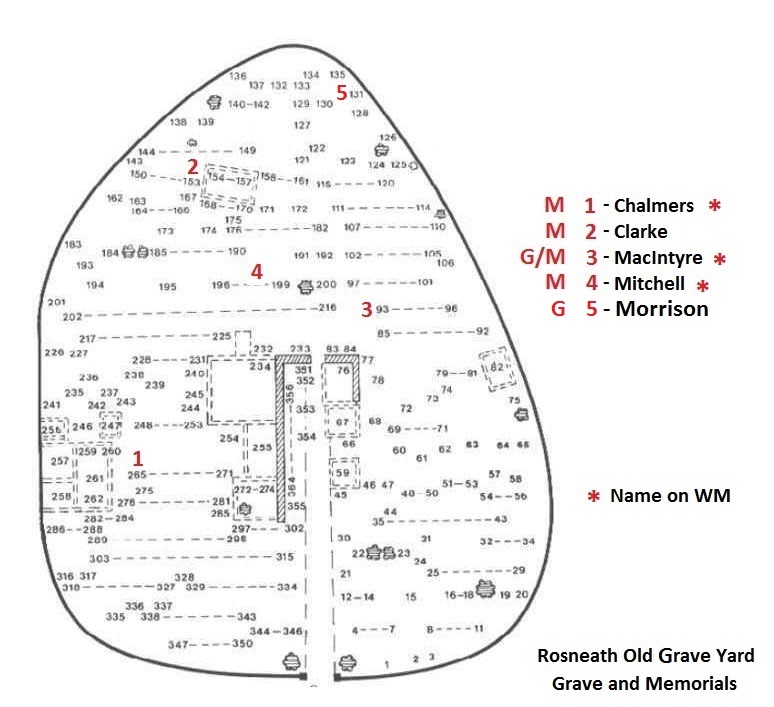
World War I
Alexander Murdoch Campbell
Lance Corporal – 4th. Bn. Attd. 3rd. Bn. London Regiment (Royal Fusiliers).*
Service No. – 283135 formerly 6490.
Date of death – 24th. March 1918.
Age – 38.
Memorial – Pozieres Memorial (No known grave).
Panel reference – Panel 85 and 86.
* CWGC data states ‘4th. Bn. Attd. 3rd. Bn’.
On his Medal Rolls Index Card are the following entries:
Corps Rank Regtl. No.
4 Lond. R Pte. 6490
3 ——–do——- 283135
There is no entry alongside ‘Theatre of War’.
None of his other Army records appear to have survived.
His name on the Pozieres Memorial would place him on the Western Front with the 4th. Bn. as the 3rd. Bn. was in Salonika with the 85th. Brigade / 28th. Division from January 1916 until July 1918.
Fourth son of Duncan and Jessie C. Campbell (nee Ferguson) of Greenock and Stonefield, Clynder. Born at Greenock in 1880. Husband of Annie Stewart Campbell, of Rosebank, 189, Merry St., Motherwell, Lanarkshire. He married Annie Stewart Easton on 10th. March 1904 in Greenock. His occupation is shown as billposters clerk. Also recorded as ‘manager’ at David Allen & Co., Billposters.
The 4th. Bn. was part of 9th. Brigade / 3rd. Division / VI Corps / Third Army in the Cherisy – Fontaine sector 6 miles S.E. of Arras when the German offensive Operation Michael started on the 21st. March 1918. This resulted in the Battle of St. Quentin (21st. to 23rd. March) when Third and Fifth army were forced to retreat.
On the 21st. the 3rd. Division was ‘strongly attacked’ North of Fontaine – les – Crosilles on the left bank of the Sensee river. The 4th. Bn. was under attack for 4 days, suffering heavy casualties, in a fighting withdrawal. On the 25th. March they were ‘not engaged’, which could be why the report below states ‘between 21st. and 24th’. This would be the first chance to draw breath and count the cost of the previous 4 days.
His name is on:
Rosneath War Memorial.
Motherwell War Memorial.
Report from The Glasgow Herald of 30th. April 1918.
CAMPBELL – Killed in action, between 21st. and 24th. March. L-Cpl. Alexander M. Campbell, Royal Fusiliers, beloved husband of Annie Stewart Easton, Rosebank, Motherwell, and fourth son of the late Duncan Campbell, Greenock and Clynder, and of Mrs. Campbell, Stonefield, Clynder.
Kenneth James Campbell
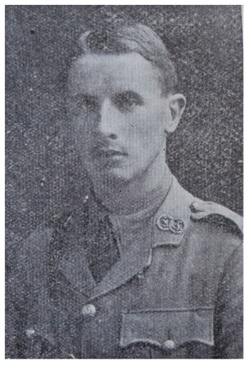
Second Lieutenant – 1st./9th. Bn. Argyll and Sutherland Highlanders.
Date of death – 12th. May 1915.*
Age – 24.
Memorial – Ypres (Menin Gate) Memorial (No known grave).
Panel reference – Panel 42 and 44.
*CWGC has 12th. Report in The Glasgow Herald has 11th. The report in the Helensburgh and Gareloch Times of letter from Major Christie, then Battalion C.O., could be 10th. or 11th. The record in De Ruvigny’s R.o.H. and his memorial plaque have the 10th.
Son of Robert Story and Evelyn Rose Campbell of Achnashie, Rosneath.
The 1st./9th. Bn. A.&S.H. were part of 81st. Brigade / 27th. Division / V Corps / Second Army in the Second Battle of Ypres (22nd. April – 25th, May 1915), during which chlorine gas was first used by the Germans.
The 27th. Division was located to the South and South East of Ypres. They were heavily engaged in the Menin Road / Hooge area. The 1st./9th. A.&S.H. had over 300 casualties on the 10th. alone and further severe casualties on the 11th.
The battalion was transferred to the 10th. Brigade / 4th. Division on 21st. May.
By the 24th. the original battalion was reduced to just 87 men.
They were combined with the 1st./7th. Bn. on the 27th. May.
His name is on:
Rosneath War Memorial.
Memorial plaque in St. Modan’s Parish Church.
Report from The Glasgow Herald of 17th. May 1915.
CAMPBELL – Killed in action at Ypres on 11th. May. Kenneth James Campbell, Second Lieutenant, 9th. Argyll and Sutherland Highlanders, aged 24, only son of Roberts S. Campbell, Achnashie, Rosneath.
Report from The Helensburgh and Gareloch Times of 19th. May 1915.
Second – Lieutenant Kenneth James Campbell, who has been killed in action, was born in 1891. He was the only son of Mr. Robert S. Campbell, of Achnashie, Rosneath, and the grandson of the late Rev. John Macleod Campbell, D.D. Educated at Marlborough, he proceeded to Oxford, where he became a scholar of Magdalen College, and had a distinguished career, taking his B.A. with honours in history in 1912, and honours in greats in 1914. Lieutenant Campbell intended taking orders in the Church of England, and on conclusion of his university course last summer he joined the Magdalen mission in Euston Road, London, and with characteristic enthusiasm he threw himself into the mission work in that crowded district. On the outbreak of the war Lieutenant Campbell, who had been for many years a cadet in the Officers’ Training Corps at Oxford, applied for a commission in the Army, and he was gazetted on September 2 last as Second-Lieutenant in the 1/9th. Battalion Argyll and Sutherland Highlanders, with which regiment he left Bedford last February for France.
Major Christie, in command of the battalion, writing to Mr. Campbell on 11th. May,
said :- ‘’We were heavily engaged yesterday and till dawn this morning, and your son was killed. Doing his duty nobly, he was struck by a shell, and died at once. He had no suffering. We have buried him here beside his brother officers near where the violets are just coming to bloom, and we are a sad, sad battalion this morning’’.
From ‘De Ruvigny’s Roll Of Honour – Vol. 1’.
CAMPBELL, KENNETH JAMES, 2nd Lieut., 9th Battn. Argyll and Sutherland Highlanders (T.F.), only s. of Robert Story Campbell, of Achnashie, Rosneath, co. Dumbarton, retired East Indian Merchant, by his wife, Evelyn Rose, dau. of the late Rev. William Henry Stokes, Vicar of Goring. a nephew of the late Sir James Campbell, K.C.I.E. (of the Bombay Civil Service and compiler of the Bombay Gazetteer), and, gdson, of the late Rev. John Macleod Campbell, D.D.; b Bombay, 4 Jan. 1891; educ. at Rottingdean and Marlborough, he proceeded with a scholarship to Magdalen College, Oxford, where he took his degree with honours in History in 1912, and in ‘’Greats’’ in 1914. He had originally intended to take orders in the Church of England, and on leaving the University in 1913 joined the Magdalen College Mission in the Euston Road. On the outbreak of war, however, having been for eight years a cadet in the O.T.C. at Marlborough and Oxford, he applied for a comission, and on 2 Sept. was gazetted to the 1/9th Argyll and Sutherland Highlanders, leaving Bedford with his regt. on 19th Feb. for France. He was killed in action near Ypres, being struck by a shell while in charge of machine guns, 10 May, 1915; unm. His comanding officer wrote that he died ‘’doing his duty nobly.’’ His platoon Sergt. that ‘’He was a brave young officer and the pride of all the platoon.’’ A brother officer, writing on 13 May, stated: ‘’I was myself slightly wounded the same day, so was not on the spot when he was killed, but I understand that he was wounded by a shell, but that he continued to serve the gun until a second shell killed him.’’ He was stroke of his college boat in the Torpids when Magdalen was head of the river in Feb. 1913.
James Andrew Wilson Chalmers (Also on the Rosneath War Memorial) was in the same Bn.
Both of their names are on the same panel locations on the Ypres Memorial.
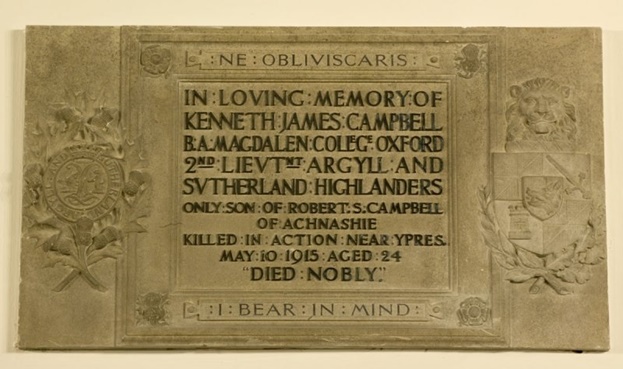
Report from The Helensburgh and Gareloch Times of 3rd.. May 1916.
Memorial Service for the Fallen.
A solemn service of commemoration for those who have laid down their lives for King and country in the war, especially for those from the Parish of Rosneath (four in number), will be held in Rosneath Parish Church at twelve noon on Sunday first, the 7th. of May. The church will be draped, and at the conclusion of the service the last post will be sounded by buglers from the Portkil Fort. The order used will be the printed form of the Memorial Office for the Dead issued by the Church Service society of the Church of Scotland, and a copy will be given to each worshipper on entering the church. During the service the mural tablet, erected to the memory of Second-Lieut. Kenneth James Campbell, B.A., 9th. Argyll and Sutherland Highlanders, who was killed in action at Hooge, near Ypres, on the 10th. of May last year, will be dedicated by the minister. It is expected that a contingent of soldiers from Portkil Fort will attend, if circumstances permit, as representing His Majesty’s Forces.
James Andrew Wilson Chalmers
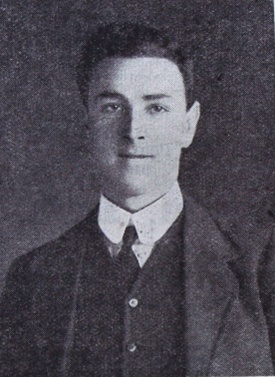
Corporal – 1st./9th. Bn. Argyll and Sutherland Highlanders.
Service No. – 2513.
Date of death – 24th. May 1915.*
Age – 23.
Memorial – Ypres (Menin Gate) Memorial (No known grave) and family Memorial in Rosneath
Old Parish Churchyard.
Panel reference – Panel 42 and 44 (Ypres).
* CWGC and his Army records have 24th May for James’ death. Report in The Helensburgh and Gareloch Times has 22nd.
Son of James and Margaret Chalmers (nee Wilson) of Little Rahane Farm. Born 27th. October 1891 at Little Rahane. The 1911 census has him at Greenlea, Rahane, occupation as grocers assistant and his parents at Hattonburn (father, retired farmer). He enlisted on 8th. September 1914 at Dumbarton.
The 1st./9th. Bn. A. & S.H. had been part of 81st. Brigade / 27th. Division / V Corps / Second Army during the Second Battle of Ypres (22nd. April – 25th, May 1915). The 27th. Division was located to the South and South East of Ypres. They were heavily engaged in the Menin Road / Hooge area. The 1st./9th. A. & S.H. had over 300 casualties on the 10th. alone and further severe casualties on the 11th. The 12th. to the 23rd. was a ‘quieter’ time.
The remains of the battalion were transferred to the 10th. Brigade / 4th. Division on 21st. May moving to the La Brique / Saint Jean / Wieltje area North East of Ypres. On the renewal of the German attacks on the 24th., they moved up to support the 1st./7th. Bn. A. & S.H. at ‘Shell Trap Farm’ North of Wieltje.
By the 24th. the original battalion was reduced to just 87 men. The survivors were combined with the 1st./7th. Bn. on the 27th. May.
His name is on:
Rosneath War Memorial.
Report from The Helensburgh and Gareloch Times of 16th. June 1915.
The relatives of Corporal James Chalmers, Clynder, have received official notice from the War Office that he was killed in action on May 22. He joined the 1/9th. A. and S. H. last September, and left for France with his regiment in February. He was 23 years of age. Prior to enlisting he was in the employment of Mr. D. C. Macpherson for eight years. Much regret is felt throughout the district, as he was well known and highly respected by all who came in daily contact with him.
Details from his surviving army records:
08/09/14 – Attestation at Dumbarton.
16/01/15 – Promoted Corporal.
19/02/15 – Embarked at Southampton for Expeditionary Force.
24/05/15 – Killed in action in the field.
Kenneth James Campbell (Rosneath War Memorial) was in the same Bn. Both of their names are on the same panel locations on the Ypres Memorial.

John Gordon
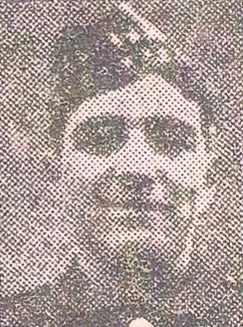
Private – 1st. Bn. Cameronians (Scottish Rifles), formerly 8th. Bn. Highland Light Infantry.
Service No. – 43533, formerly 6896.
Date of death – 14th. April 1918.
Age – 21.
Memorial – Ploegsteert Memorial (No known grave).
Panel reference – Panel 5.
CWGC Reference
Son of Allan and Henrietta Gordon (nee Mitchell) of Carluke. Born on 23rd. March 1897 at John Street, Carluke.
He married Mary Jane Livingstone* on 20th. October 1915 at Rosneath. His occupation recorded as ‘Coalminer – Private 8th. H.L.I.(T), Ambulance Corps’ at Portkil. Mary was a cook living at the Home Farm.
* Mary Jane Livingstone was the elder sister of Hugh Livingstone who was KIA on 26th. September 1915 at Loos.
The 1st. Bn. Cameronians were part of 19th. Brigade / 33rd. Division / XV Corps / First Army when Haig issued his ‘Backs to the Wall’ order on the 11th. April 1918 during the German offensive Operation Michael.
As the Battle of Hazebrouck (12th. to 15th. April), one of the Battles of the Lys (9th. to 29th April), started XV Corps was transferred to Second Army and the 19th. Brigade of 33rd. Division was rushed into the gap the Germans had opened up between 31st. and 34th. Divisions at Meteren (6 miles East of Hazebrouk). They held their position.
His name is on:
Rosneath War Memorial.
There is also Pte. John Gordon on Carluke War Memorial.
Report from the Evening Times of 20th. May 1918.
Pte. J GORDON.
Roseneath.
Intimation has been received by Mrs. Gordon, Castle Grounds, Roseneath, that her husband, Private John Gordon, Scottish Rifles, was killed in action on April 14. He was 21 years of age. He leaves a widow and one child.
Peter Haig – M.M.
Private -7th. Bn. Gordon Highlanders, formerly Argyll and Sutherland Highlanders.
Service No. – 310357, formerly 4210 .
Date of death – 4th. December 1917.
Age – 28.
Memorial – Cambrai Memorial, Louverval (No known grave).
Panel reference – Panel 10.
Youngest son of Peter and Jane Haig of The Clachan, Rosneath. Born in Dumbarton.
There is an entry in one of the Scottish War Memorial Project sites that he enlisted at Lerwick.
At the time he earned his M.M. the 7th. Bn. Gordon Highlanders were part of 153rd. Brigade / 51st. (Highland) Division / XVIII Corps / 5th. Army at the Battle of Pilkem (31st July – 2nd. August), North of Ypres, which was the first phase of 3rd. Ypres (Passchendaele). The initial advance on the 31st. July went well … and then the rain started.
At the time of his death the 51st. (Highland) Division was part of V Corps / Third Army at the Battle of Cambrai (20th. Nov. – 30 Dec. 1917). After the initial successes the German counter-attacks (30th. Nov. – circa 7th. Dec.) regained much of the hard won ground.
In the Helensburgh and Gareloch Times of 11th. December 1918 there was a notice ‘In Memoriam’ stating that ‘Pte. Peter Haig, M.M., Lewis Gunner’ was ‘killed in action at Moeuvres’, which is some 4 miles N.N.W. of Flesquieres. The 51st. Division was located in the Flesquieres area at the Battle of Cambrai during the German counter-attack.
His name is on:
Rosneath War Memorial.
Dumbarton War Memorial.
Report from the Helensburgh and Gareloch Times of 12th. September 1917.
Rosneath Soldier Gains Military Medal.
Mr. and Mrs. Peter Haig, The Clachan, have received intimation that their son, Private Peter Haig, Gordon Highlanders, has been awarded the Military Medal for gallantry in the course of an advance on 31st. July last in France. He is 26 years of age, and a native of Dumbarton. He joined the colours last November, and went to the front early this year. Prior to enlisting he was branch manager with the Dumbarton Equitable Co-operative Society in their Dunoon establishment.
Report from the Helensburgh and Gareloch Times of 19th. December 1917.
Rosneath Soldier Killed in Action.
Preaching in the U.F. Church on Sunday last Rev. J. Dykes lang made reference, towards the close of his sermon to the loss of Private Peter Haig, ‘C’ Company, Gordon Highlanders. Intimation came on Tuesday to the effect that Peter Haig, one of our members, had been killed in action on the 4th. inst. He was a private in the Gordon Highlanders, and in a former engagement had so distinguished himself that he earned the Military Medal. I have no doubt that he was doing noble deeds in the noblest spirit when he met with his fatal wounds. He was one of our young communicants a short time ago. A pure-minded lad – gentle, loving, and fearless – and greatly beloved. Early in the war he had offered himself voluntarily, but it was then thought that he was not robust enough for soldiering, and, when he was accepted, he proved himself a fit and heroic servant of his King and country. We mourn the loss of such a capable and good man, and our sympathy goes out to his parents and relatives in this painful bereavement.
Ours is the sorrow and the loss,
Thine the eternal gain:
To us the dark and bitter cross,
To thee the end of pain.
Ours is the vacancy and grief,
Thine fullest life and long;
To us the struggle stern and brief,
To thee the victor’s song.
Ours is the burden hard to bear,
Thine all things meet and best;
to us the constant toil and prayer,
To thee the peaceful rest.
Ours is the life dream-like and vain,
Thine happiness and peace;
To us earth’s changing things remain,
To thee heaven’s joys increase.
Report from The Glasgow Herald of 21st. December 1917.
HAIG – Killed in action on 4th. December. Private Peter Haig, Gordon Highlanders, youngest and beloved son of Peter and Jane Haig, The Clachan, Rosneath, Dumbartonshire.
Extract of report in the Helensburgh and Gareloch Times of 23rd. January 1918.
Rosneath War Honours.
On the kind invitation of Mr. and Mrs. M’Millan a small company met in Kilarden on Friday evening, and after partaking of their generous hospitality, Mr. Cameron, Chairman of Rosneath Parish Council, made the following presentations on behalf of their fellow parishioners, viz.:- To Mr. and Mrs. Haig, a gold locket and brooch in memory of their son, Private Peter Haig, Gordon Highlanders, who won the Military Medal for bravery on the field in France.
William McLean Kennedy
Private – 13th. Field Ambulance, Canadian Army Medical Corp.
Service No. – 532666.
Date of death – 8th. March 1917.
Age – 29.
Cemetery – Bruay Communal Cemetery Extension.
Grave reference – D. 2.
Only son of Daniel Paterson and Agnes Jamieson Kennedy (nee Montgomery), of Greenock.
SNWM has born in Greenock. The 1901 and 1911 census show his place of birth as U.S of America. Canadian records have date of birth as 17th. October 1887. See below.
Daniel Paterson Kennedy (born in Greenock) married Agnes Jamieson Montgomery in Greenock on 2nd. March 1886. They had two children, William and Maggie.
Agnes must have died, as Daniel, recorded as widower, remarried Mary Maclean in Rosneath on 18th. April 1900. Usual residence shown as The Clachan.
The 1901 census shows the family at Craig Cottage, Rosneath.
The 1911 census shows the family at Clachan, Rosneath. Mary’s marriage duration is shown as 10 years, children, none. William’s occupation is shown as a ‘house factors clerk’ and he and his sisters nationality as ‘British subject by parentage’.
Canadian records, of Scots in Canadian forces, state that he ‘enlisted’ and ‘died in war, cause unknown’.
The 13th. Field Ambulance was attached to 4th. Canadian Division / Canadian Corps / First Army and was located to the North of Arras and West of Lens (i.e.. West of Vimy Ridge) in the preparation for the Battle of Vimy (9th. – 14th. April 1917), part of the Second Battle of Arras.
The 4th. Division was very active in this period and their field ambulances were busy. Their stretcher bearers regularly out in the no-man’s land of Zouave Valley bringing in casualties of the 11th. and 12th. Canadian Brigades.
The 13th. F.A. war diary, for the 8th. March, details a move from Villers au Bois to
Hersin – Coupigny (West of Lens) taking up accommodation in the Chateau de Coupigny and a convent at Hersin. The diary does not record any F.A. casualties for the month of March, but see below.
His name is on:
Rosneath War memorial.
Greenock War memorial.
Report from The Glasgow Herald of 15th. March 1917.
KENNEDY – Died in hospital on 8th. inst., Private William M’Lean Kennedy, Canadian Contingent, R.A.M.C., only son of Mr. D. P. Kennedy, Vancouver and formerly at Greenock and Rosneath.
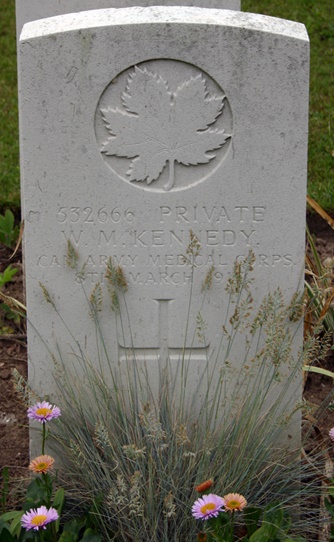
James Kerr
Private – 1st./5th. Bn. King’s Own Scottish Borderers.
Service No. – 201709.
Date of death – 19th. April 1917.
Age – 37.
Memorial – Jerusalem Memorial (No known grave).
Panel reference – Panel 23 and 24.
Son of John and Mary Kerr, born Lockerbie. Husband of Agnes Kerr (nee MacDonald), married 12th. November 1907. He enlisted at Dumbarton.
The 1911 census has him, his wife (born Cove) and son, who was born at Bellcairn, Cove, at Barremman Cottages, Clynder.
The 1st./5th. Bn. K.O.S.B. were part of 155th. Brigade / 52nd. (Lowland) Division / Egyptian Expeditionary Force at the Second Battle of Gaza (17th. to 19th. April 1917).
At 07.30 on the 19th. April the Division attacked along Es Sire ridge. The 155th. Brigade secured the ridge and moved on to take Outpost Hill. They were subjected to Turkish counter attacks and the hill changed hands several times. They had to withdraw from the hill later that day. There were over 1300 casualties in the 52nd. Division alone.
His name is on:
Rosneath War Memorial.
Casualty Lists in The Glasgow Herald of 21st. May 1917.
MISSING.
Kerr (201709), J. (Dumbartonshire).
Lawrence Wilson Thom (Rosneath War Memorial) and Ernest Leopold Claasen (Cove & Kilcreggan War Memorial) also died in this battle.
Hugh Livingstone
Private – 7th. Bn. Royal Scots Fusiliers.
Service No. – 15252.
Date of death – 26th September 1915.
Age – 19.
Memorial – Loos Memorial (No known grave).
Panel reference – Panel 46 to 49.
Son of John, ploughman, and Maggie Livingston – (nee Galbreath). Born 22nd. May 1896 at Barbreck, Inishail, Kilchrennan.
The 1911 census has a Hugh ‘Livingston_’, age 14, at Mamore Farm as a labourer. Place of birth as Killachrennan (Kilchrenan), Argyll.
There is also John Livingston_, ploughman, (aged 49) with a son (aged 11), a daughter (aged 2) and wife Mary (aged 27), married for only 4 years with one child, at Clachan Farm. A second marriage it seems.
The name with and without the ‘e’ is bit of a problem, but the above seems to fit.
To muddy the water further, SNWM and ‘UK Soldiers Died in the Great War, 1914 – 1919’ have his place of birth as Carnwath, Lanarkshire and enlistment at Edinburgh. See report dated 1st. December 1915 below.
The 7th. Bn. Royal Scots Fusiliers was part of the 45th. Brigade / 15th. Division / IV Corps / First Army at the Battle of Loos (25th. Sept. to 19th. October). They had been with K2 army, but transferred to First Army on the 17th. July.
On the 25th. the 15th. Division attacked and took Loos and gained ground on Hill 70. Over the next few days Hill 70 was bitterly contested with heavy casualties.
His name is on:
Rosneath War Memorial.
There is a Hugh Livingstone on Carnwath War Memorial.
Report from the Helensburgh and Gareloch Times of 10th. November 1915
The Rosneath Parish Church Supplement contains the following:- Another of our number has made the supreme sacrifice – Private Hugh Livingstone, 7th. Battalion Royal Scots Fusiliers, who fell in battle on Sunday, September 26. Hugh Livingstone died at the early age of 19 years, but he has not died in vain, for he took part in the great advance of the Allied Forces, and helped to achieve a brilliant victory. He has left a name which the parish will keep for ever on its roll of heroes who have fallen in the war.
Report from the Helensburgh and Gareloch Times of 1st. December 1915
Rosneath Soldier Killed.
Mr. John Livingstone, Home Farm, Rosneath, has received intimation that his son, Private Hugh Livingstone, 7th. Battalion Royal Scots Fusiliers, was killed in action at Loos on 26th. September. Deceased, who was a native of Kilchrenan, Argyllshire, was 19 years of age, and was employed at Carnwath prior to enlisting.
William James Matheson Shaw (Rosneath War Memorial) was in the 11th. Bn. Argyll and Sutherland Highlanders who were also part of the 45th. Brigade. Both of their names are on the Loos Memorial.
Duncan MacIntyre
Private – 11th. Bn. Cameronians (Scottish Rifles).
Service No. – 28605.
Date of death – 24th. December 1917.*
Age – 23.
Cemetery – Rosneath Old Parish Churchyard.
Grave location – North West corner of old church.
* CWGC data base and gravestone have date of 24th. February 1917.
SNWM date is 24th. December 1917 and this is also the date in the Glasgow Herald of the 27th. and 28th. December 1917 (see below) and on family memorial stone in Rosneath Old Churchyard, which is alongside the CWGC stone – see pictures below.
Eldest son, of five, of Alexander and Jessie MacIntyre of Little Rahane Farm, Clynder. Born on Canna, Small Isles, Inverness on 21st. May 1894. The 1911 census shows him, age 16, as working on the farm.
The 11th. Bn. Cameronians were part of 77th. Brigade / 26th. Division / K3 Army. The Division had gone to France in September 1915, but then moved to Salonika in November. The Division had over 8,000 casualties in action against the Bulgarian Army in the Salonika Theatre, but vastly larger numbers from malaria, dysentery and other diseases.
His death was registered in the sub-district of Westbury-on-Trym. County of Bristol.
Entry No. 139 on 24th. December 1917 at 2nd. Southern General Hospital, Southmead.
Name entered as Duncan McIntyre, Private 11th. Scottish Rifles, 2 Coy., No. 28605, Little Rahane Farm, Clynder. Cause of death – Pulmonary Tuberculosis.
Report from The Glasgow Herald of 28th. December 1917.
MACINTYRE – Died, Southmead Hospital, Bristol, 24th. Inst., Private D. MacIntyre, eldest son of Mr. and Mrs. MacIntyre, Little Rahane Farm, Roseneath. Funeral on arrival of midday steamer, to-day (28th. December).
Extract from the Helensburgh and Gareloch Times of 2nd. January 1918.
Mr. and Mrs. M’INTYRE and FAMILY return sincere thanks for the many kind expressions of sympathy and floral tributes received in their recent sad bereavement. – Little Rahane Farm, Rosneath.
His name is on:
Rosneath War memorial.
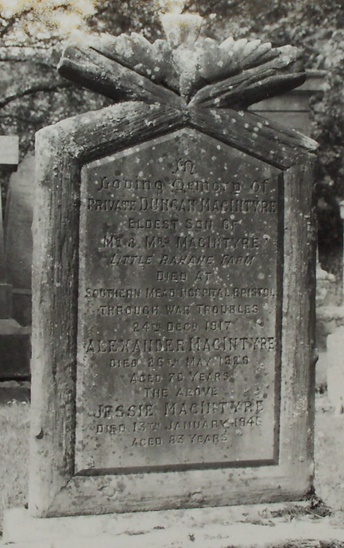
In
Loving Memory of
PRIVATE DUNCAN MACINTYRE
ELDEST SON OF
MR. & MRS. MACINTYRE
Little Rahane Farm
DIED AT SOUTHERN MEAD HOSPITAL, BRISTOL
THROUGH WAR TROUBLES
24TH DECR 1917
ALEXANDER MACINTYRE
DIED 26TH MAY 1929
AGED 70 YEARS
THE ABOVE JESSIE MACINTYRE
DIED 13TH JANUARY 1946
AGED 83 YEARS
Wording on Family Memorial.
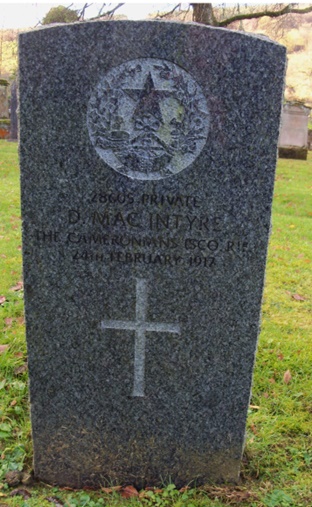
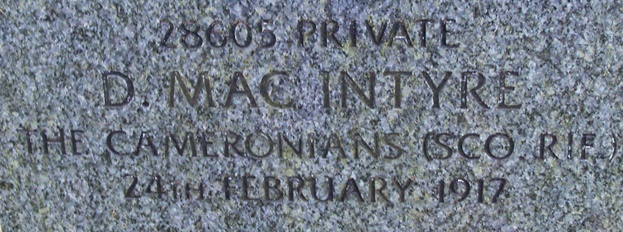
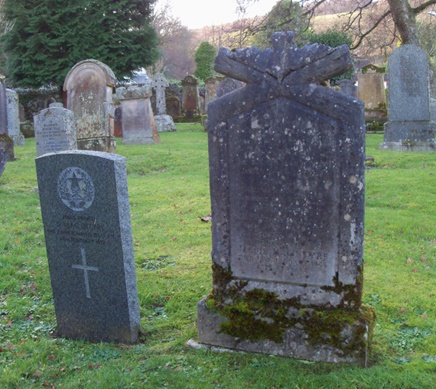
Robert Mitchell
Private – 20th. Bn. The Kings Liverpool Regiment, formerly 1108 Army Cyc. Corps*.
Service No. – 57450.
Date of death – 9th. April 1917.
Age – 20.
Cemetery – Henin Crucifix Cemetery and family Memorial in Rosneath Old Parish Churchyard.
Grave reference – A. 11. (Henin).
*Ref. SNWM.
Fifth** son of Duncan and Jane Arthur Mitchell, Stroul Villa, Rosneath (CWGC). Born at Elmbank, Clynder on 11th. January 1896. Enlisted in Glasgow.
The 20th. Bn. Kings Liverpool Regiment (4th. Liverpool Pals) were part of 89th. Brigade / 30th. Division / VII Corps / Third Army during the Arras Offensive (9th. April – 16th. June 1917).
The 1st Battle of the Scarpe was one of the opening phases, commencing at 05:30 on the 9th. April. The 30th. Division, to the South of the Scarpe, took St. Martin – sur – Cojeul (Approx. 5 miles S.S.E. of Arras). The 89th. Brigade encountered uncut wire and suffered heavy casualties.
His name is on:
Rosneath War memorial.
Report from the Helensburgh and Gareloch Times of 25th. April 1917.
Clynder Soldier Killed.
Intimation has been received by Mr. and Mrs. Duncan Mitchell, Cona Cottage, Clynder, that their fourth son, Private Robert Mitchell, was killed in action on 9th. April. Private Mitchell, who was only 20 years of age, was with the Black Watch in the great advance.
** He was the fifth son. The eldest son, Alexander, was drowned in the Gareloch in 1893. See family memorial below. In age order the sons were – Alexander, John, Duncan, Peter, Robert and William.
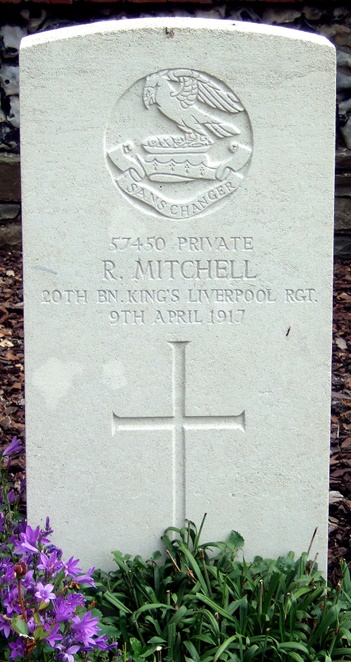
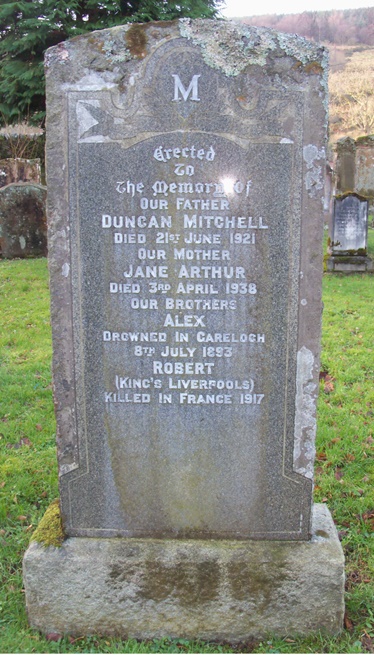
William James Matheson Shaw
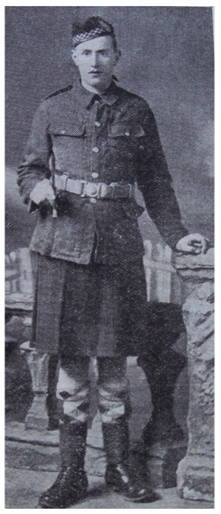
Private – 11th. Bn. Argyll and Sutherland Highlanders.
Service No. – S/6432.
Date of death – 27th. September 1915.
Age – 20.
Memorial – Loos Memorial (No known grave).
Panel reference – Panel 125 to127.
Son of John and Jessie Rattray Shaw of Hattonburn Cottage, Clynder. The 1911 census has him as an apprentice gardener, born Rosneath.
11th. Bn. A. & S. H. formed at Stirling in Sept. 1914 as part of K2 Army. Attached to 45 Brigade / 15th. Division. They moved to Bramshott in Nov., Basingstoke in Feb. 1915 and Chiseldon in Apr. 1915. They landed at Boulogne on 9th. July 1915 becoming part of IV Corps. The Corps transferred to First Army on the 17th. July and took part in the Battle of Loos (25th. Sept. to 19th. October).
On the 25th. the 15th. Division attacked and took Loos and gained ground on Hill 70. Over the next few days Hill 70 was bitterly contested with heavy casualties.
His name is on:
Rosneath War Memorial.
Report from the Helensburgh and Gareloch Times of 24th. November 1915.
Private WILLIAM SHAW.
Mr. and Mrs. John Shaw, Hattonburn Cottage, Clynder, have received information from the War Office that their son, Private Wm. Shaw (6432), 11th. Argyll and Sutherland highlanders, has been posted missing since September 27. Any information from any of his comrades would be gratefully received by his parents. He is 20 years of age, and prior to enlisting was gardener to Mrs. Thom, Barremman House, Barremman.
Details from his surviving Army records:
14/11/14 – Attestation at Dumbarton.
18/11/14 – Posted to 11th Bn. at Bramshott, Hampshire.
09/07/15 – Embarked for France.
26/09/15 – Reported missing.
27/09/15 – Regarded for official purposes as having died on or since this date.
Hugh Livingstone (Rosneath War Memorial) was in the 7th. Bn. Royal Scots Fusiliers who were also part of the 45th. Brigade. Both of their names are on the Loos Memorial.
*Robin Reginald Tatlock
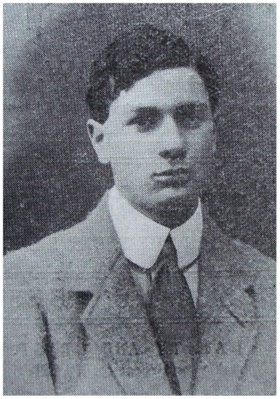
Lieutenant – Army Service Corps.
Date of death – 19th. June 1916.**
Age -26.
Cemetery – Salonika (Lembet Road) Military Cemetery.
Gave reference – 0.6
*Name on War Memorial in St. Modan’s Parish Church. His given name of Robert Reginald Tatlock is on his memorial plaque in the church. On a letter written to his father, dated 14th. May 1915, concerning his will, he signed it ‘Robin’.
** CWGC and his grave stone have ‘Robert Rattray Tatlock’ and date of the 18th. (‘Robert Rattray Tatlock’ was his father’s name). His Medal Rolls Index Card has date of the 19th.
Second son of Robert Rattray and Christian Lawson Tatlock (nee Aitken) of Kilarden, Rosneath. Born on 5th. July 1889 at 2, Dundonald Road, Kelvinside, Partick.
In the supplement to the London Gazette dated 14th. January 1915, he is shown as promoted from Second Lieutenant to Lieutenant in the 3rd. Company of the Lowland Divisional Train (52nd. Division).
In the letter to his father, dated 14th. May 1915, he gives his address as ‘No. 2 Company A.S.C., 155th. (South Scottish) Brigade, 52nd. Division.’
The 52nd. Lowland and 10th. Irish Divisions both served in Gallipoli. In October 1915 the A.S.C. Companies of the 52nd. Division were transferred to the 10th. Division and retitled as No’s. 471 through 474. The 10th. Irish Division moved to Salonika on 10th. October 1915.
His Medal Rolls Index Card has ‘entry into Theatre of War’- Salonika, October 1915.
Over 50% of the deaths in the Salonika campaign were due to sicknesses like malaria or dysentery.
His name is on:
Rosneath War Memorial.
Memorial plaque in St. Modan’s Parish Church
Merchiston Castle School, WW1 Memorial, panel 6.
Reports from The Glasgow Herald of 27th June 1916.
TATLOCK. – Suddenly, on the 19th. inst., at Salonika, Robert Reginald (Lieut., A.S.C.), second son of R. R. Tatlock, Kilarden, Rosneath, Dunbartonshire, City Analyst of Glasgow.
MR. R. R. TATLOCK, A.S.C.
Lieutenant Robert Reginald Tatlock, A.S.C., who died in hospital at Salonika on the 19th. inst., was the second son of Mr. R. R. Tatlock, F.R.S. (Edin.), Kilarden, Rosneath, City Analyst of Glasgow, by his marriage with Christian, only child of the late Rev. Charles S. Aitken, B.A. (Oxon.) of Cuparhead House, Lanarkshire. Born in 1889, he received his education at Stanley House and Merchiston Castle Schools. After studying motor engineering for a year in Paris, he entered the Argyll Motor Works, and received his commission in October, 1914. In May, 1915, he proceeded to Gallipoli, and afterwards participated in the Serbian retreat.
Report from the Helensburgh and Gareloch Times of 28th. June 1916.
We regret to announce the death of Lieut. Robert Reginald Tatlock, A.S.C., second son of Mr. R. R. Tatlock, F.R.S. (Edin.), Kilarden, Rosneath, by his marriage with Christian, only child of the late Rev. Charles Aitken, B.A. (Oxon.), sometime Rector of Farque, which took place in hospital at Salonika on the 19th. inst. Born in 1889, he received his education at Stanley House and Merchiston Castle Schools. After studying motor engineering for a year in Paris, he entered the Argyll Motor Company, and received his commission in October, 1914. He subsequently went to Gallipoli in May, 1915, and later took part in the Serbian retreat. Lieutenant Tatlock belonged to a distinguished family. His father, Mr. Robert Rattray Tatlock, is one of the most prominent scientific chemists in Britain, and, besides having been City Analyst of Glasgow for almost forty years, was one of the founders and is an honorary Fellow of the Institute of Chemistry of London, and three years ago was elected President of the Society of Analysts of Great Britain and Ireland. During his long career he has been employed as an expert, not only many times in the House of Lords, but also on the Continent and in South Africa. His family have been connected with Glasgow and its neighbourhood since 1647. On his mother’s side, Lieutenant Tatlock came of a race of clergy. His great-grandfather, who married the last survivor of the family of Colonel Eyre of Eyreton, isle of Man, was Vicar of Pendeen, Cornwall, and during the stormy ecclesiastical years of the early nineteenth century was one of the most prominent figures in the Church of England. Of his three sons, Robert succeeded him in Pendeen, another is the well known Canon Hay Aitken of Norwich Cathedral, and the third, Charles, Lieutenant Tatlock’s grandfather, also an Anglican clergyman, married Christian, daughter of Rev. John Clelland, a minister of the Church of Scotland, whose wife inherited the lands of Cuparhead and Souterhouse, in Lanarkshire, which have now since passed from the family.
Grave in Salonika (Lembet Road) Military Cemetery.
Memorial plaque in St. Modan’s Parish Church
Merchiston Castle School, WW1 Memorial, panel 6.
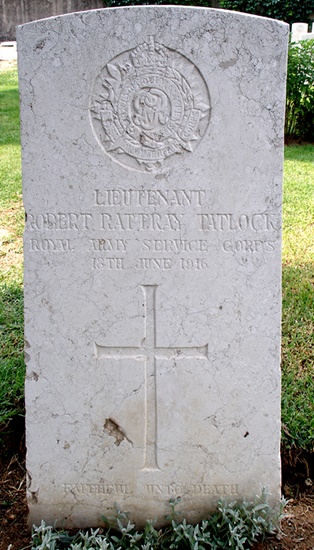
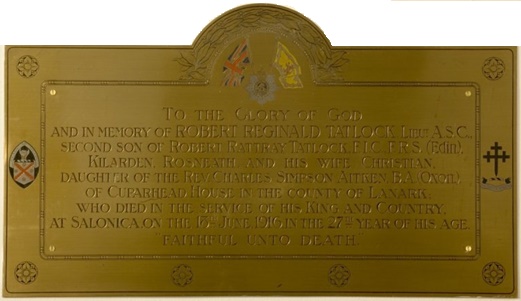

Lawrence Wilson Thom
Lieutenant – 1st./8th. Bn. The Cameronians (Scottish Rifles), formerly London Scottish
(see Below).
Date of death – 21st. April 1917.
Age – 30.
Cemetery – Kantara War Memorial Cemetery – Cairo.
Grave reference – B. 170.
Youngest son of Robert Wilson and Eliza Thom (nee Young) of 9, Woodside Terrace, Glasgow. He was born on 8th. April 1887 at the same address. On the register of births for the district of Kelvin his name is spelt ‘Laurence’.
On his Medal Rolls Index Card his name is spelt ‘Laurence’.
This card is headed Campaign: ‘1914 – 15’ and has alongside Theatre of War: ‘France’. Added below is ‘Gallipoli 1.9.15 ?’
On the Glasgow Academy Roll of Honour, his details are:
Private, London Regt. (London Scottish); 2nd. Lieut., Scottish Rifles; Lieut.; died of wounds 21st. April 1917.
The 8th Bn. Cameronians were part of 156th. Brigade / 52nd. (Lowland) Division / Egyptian Expeditionary Force. The 52nd. Division had been moved to Egypt after the evacuation from Gallipoli in January 1916. The Division was in reserve during the First Battle of Gaza, but took part in the Second Battle of Gaza (17th. to 19th. April 1917).
At 07.30 on the 19th. April the Division attacked along Es Sire ridge towards Gaza and Ali Muntar. The 156th. Brigade were echeloned behind and to the right of 155th. Brigade. The two brigades were to take the ridge and then jointly swing on Green Hill and Ali Muntar. The 8th. Cameronians were stopped by Turkish fire from Middlesex and Outpost Hills and caught in the open for five hours. The attack was a disaster with over 1300 casualties in the 52nd. Division alone.
His name is on:
Rosneath War Memorial.
Glasgow Academy Roll of Honour.
Reports from The Glasgow Herald of 26th. April 1917.
THOM – Died of wounds, on 21st. April. Lawrence Wilson Thom, C.A., Lieut., Scottish Rifles, aged 30, youngest son of the late R. Wilson Thom, and of Mrs. Wilson Thom, 9, Woodside Terrace, Glasgow.
Death of Lieutenant L. W. Thom.
Lieutenant Lawrence Wilson Thom, who died of wounds on 21st April, was the youngest son of the late Mr. R. Wilson Thom and Mrs. Wilson Thom, 9, Woodside Terrace, Glasgow, and a grandson of the late Mr. Robert Thom , Barremman. He was educated at Glasgow Academy, and served his apprenticeship as a chartered accountant with Messrs Moores, Carson, & Watson C.A. He joined the London Scottish at the outbreak of war, and in the following spring received a commission in the Scottish Rifles. Lieutenant Thom went through the Gallipoli campaign, and afterwards served in Egypt.
(Also repeated in the Helensburgh and Gareloch Times of 2nd. May 1917).
James Kerr of Clynder (Rosneath War Memorial) and Ernest Leopold Claasen (Cove & Kilcreggan War Memorial) also died in this battle. Laurence Wilson Thom (grave B. 170) and Ernest Leopold Claasen (grave B. 129) lie in the same cemetery.
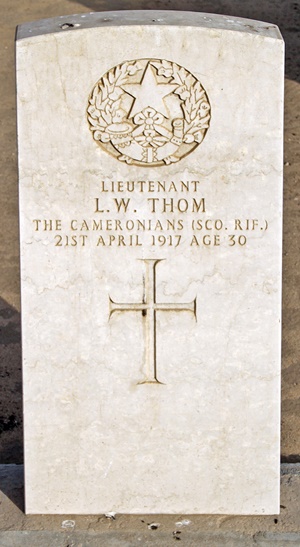
Lewis Alexander Watt
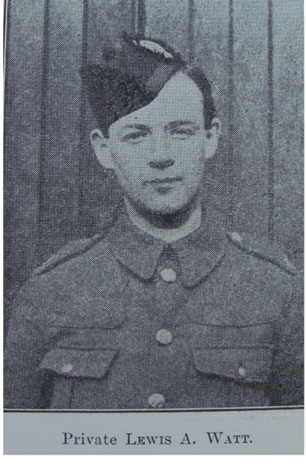
Private – 1st./8th. (Argyllshire) Bn. formerly 1st./9th. (Dunbartonshire) Bn. Argyll and Sutherland Highlanders,
Service No. – 5590, formerly 2993.
Date of death – 13th. November 1916.
Age – 20.
Cemetery – Mailly Wood Cemetery, Mailly-Maillet and family memorial in Barbour Cemetery.
Grave reference – I. E. 21. (Mailly Wood).
Eldest son of Adam F., painter, and Janet Watt of Carriden Cottage, Kilcreggan. Born on 20th. November 1895 at Princes Terrace, Kilcreggan. Enlisted in Helensburgh.
‘City of Glasgow Roll of Honour of The Great War, 1914 – 1918’ – has address of 73, North Frederick Street and unit as Australian Infantry Force.
The 9th. Bn. A. & S. H. were part of 81st. Brigade / 27th. Division / 5 Corps / 2nd. Army until 21st. May 1915 when they transferred to the 10th. Brigade / 4th. Division. They were heavily engaged during the Second Battle of Ypres (22nd. April – 25th. May 1915). In July 1915 the few survivors left the 4th. Division to become Corps Troops to 6 Corps and then used as a draft supply unit. (This ‘fate’ of the 9th. Bn. caused uproar at home, after all they had been through).
When he joined the 8th. Bn. A. & S. H. they were part of 152nd. Brigade / 51st. (Highland) Division / 5 Corps / 5th. Army during the Battle of the Ancre (13th. – 18th. Nov.), the last major engagement of the Battles of the Somme in 1916. On the 13th. the 51st. Division fought through Y Ravine, where he was killed, and took Beaumont-Hamel.
His name is on:
Cove and Kilcreggan War Memorial.
Craigrownie Parish Church War Memorial.
Rosneath War Memorial.
Report from the Helensburgh and Gareloch Times of 19th. April 1916.
PRIVATE LEWIS WATT. – Mr. and Mrs. Watt, Carriden, Kilcreggan, have been informed that their son, Private Lewis Watt, of the 1/9 A. & S. H. has been admitted to No. 9 Stationary Hospital, France, suffering from a nervous breakdown. Private Watt has been at the front for 11 months, and has been through all the actions in which the county battalion has been engaged. His many friends in the district wish him a speedy recovery, when it is expected that his furlough, which his illness has delayed, will be granted, and that he may have a pleasant holiday at home after his long period of active service.
Report from the Helensburgh and Gareloch Times of 13th. December 1916.
Kilcreggan Soldier Killed.
Mrs. Adam Watt, Carriden, Kilcreggan, has received official intimation that her son, Private Lewis Watt, was killed in action at the Ancre on 13th. November. Private Watt was the eldest son of Private and Mrs. Adam Watt, and was 20 years of age. He enlisted in the county battalion in November, 1914, and has seen much active service at Ypres and in other engagements in which the battalion distinguished itself. He was for some time in hospital with rheumatics. After discharge form hospital he was drafted to the 8th. Argylls. Private Watt was one of the first of the young men from the district to join up after the outbreak of war. Private Adam Watt, father of the deceased soldier, was an enthusiastic member of the Volunteer Corps from its inception, and a few weeks ago enlisted in the Royal Defence Corps, and is now stationed on military guard duty at Didsbury.
Details from his surviving Army records:
12/11/14 – Attestation at Helensburgh into the 9th. Bn. Service No. 2993.
03/05/15 – Embarked at Southampton for Expeditionary Force.
08/03/16 – Admitted to hospital ‘in the field’, then to Rouen. No cause given.
09/03/16 – To No. 9 Stationary Hospital, Le Havre. No cause given. (See newspaper reports
above, ‘nervous breakdown’ or ‘rheumatics’.
Also there is no mention in his records of any leave).
06/09/16 – Transferred to 1/8th. Bn. Service No. 5590 (the only number on his Medal Rolls
Index Card).
13/11/16 – Killed in action.
Not much detail for what he went through.
Extract from ‘The 51st. (Highland) Division, War Sketches’ by F. A. Farrell.
The Battle of the Ancre, whereof the storming of Beaumont-Hamel was a vastly important operation, opened on November 13th. 1916, at six o’clock on a foggy morning, after two hours’ intense bombardment, which destroyed the greater part of the German wire entanglements.
Behind a terrific artillery barrage three divisions advanced to the attack, the 51st. being in front of Beaumont-Hamel, with the 63rd. Naval Division on its right and the 39th. Division on its left.
A serious natural obstacle confronted the Highlanders in a deep fold of the ground known as Y Ravine, which ran down from the village to the German trenches, and the ground in general over which their advance was made was horrible with the dead and the litter of the struggle here in the previous July. The 152nd. and 153rd. Brigades led the attack, which quickly carried the front German lines and swept through Y Ravine after a bitter bayonet conflict; and the whole Division, now hurled into the assault, burst in upon the village with its sinister network of caverns and strong points with a Highland elan that was irresistible. It was, said the Corps Commander, “one of the greatest feats of the war, and to those who know the ground and its defences it must ever be a marvellously fine performance.” Six or seven thousand prisoners were taken by the Division, whose casualties, though grievous enough, were considerably less than had been calculated on.
This latter fact, no doubt, accounts for the 51st. being the only Division to go back immediately into the line again.
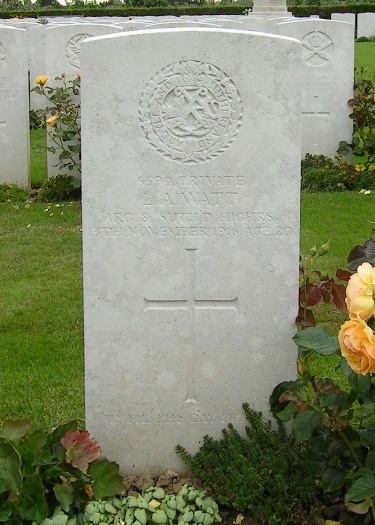

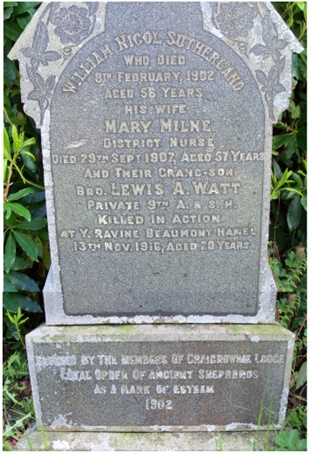
To date, there has been difficulty in tracing details of two of the following two men who died in World War I.
If readers have any addition information of recommendations they would like to add, or delete, please feel free to contact Tony Belk or this site and discuss.
George White
Service No. –
Date of death –
Age –
Matthew White
Service No. –
Date of death –
Age –
Harry Hill
Service No. –
Date of death –
Age –
Peter Jones
Service No. –
Date of death –
Age –
Ian McMurchie.*
Second Officer – Merchant Navy,
S.S. Pennington Court.
Date of death – 9th. October 1942.
Age – 24.
Memorial – Tower Hill Memorial.
Panel reference – Panel 80.
* His given name was the same as his father – John Welsh McMurchie. See report below.
Son of John Welsh and Ellice Isles McMurchie (nee Macleod) of Crossowen House, Clynder. SNWM has his place of birth as Grimsby.
The S.S. Pennington Court, which left New York on 26th September 1942 bound for Liverpool, with convoy SC103, was carrying 8,330 tons of grain and a deck cargo of 164 tons of trucks when, as an unescorted straggler, some 500 miles E.S.E. of Cape Farewell (58 deg. 18 min. N, 27 deg. 55 min. W) at 21:01 hrs. on the 9th. October 1942 she was hit by a torpedo from U-254.
She was still moving slowly when another torpedo was fired at her at 21:45, but this missed. While the crew abandoned ship and sent distress signals, U-254 reloaded torpedoes. A high swell preventing use of the deck gun, another torpedo was fired, hitting midships and she sank by the bow. (3 hits from 6 torpedoes fired).
The U-boat left, in a failed effort to chase another straggler, without questioning the survivors.
The lifeboats were never found. All 40 crew were lost.
U-254 was itself sunk on 8th. December 1942 after a collision with U-221 at 58 deg. 45 min. N, 33 deg. 02 min. W (E.S.E. of Cape Farewell). There were only 4 survivors from the crew of 45.
Report from The Glasgow Herald of 10th. November 1942.
MACMURCHIE – Lost at sea, in October, 1942 by enemy action. John Welsh (Ian), 2nd. officer, Merchant Navy, aged 23 years, the well loved son of Mrs. Ellice Macmurchie, Crossowen House, Clynder, Dumbartonshire, and of Lieutenant Commander Macmurchie, D,S.O. R.N.V.R. – No letters please,
His name is on:
Rosneath War Memorial.
His father also died during the war and his details are below
John Welsh McMurchie.
Lieut. Commander*
H.M.S. Yeoman.
Date of death – 8th. January 1944.
Age – 68.
Cemetery – Muckairn Parish Churchyard.
Grave location – Old ground South of church.
Also Listed in SNWM
*Royal Naval records have Ty./Act./Lieut. Commander R.N.V.R. Yeoman. Died of illness.
Son of Hugh and Janet McMurchie. Husband of Ellice (Lizzie) Isles McMurchie (nee Macleod) of Clynder. He received the D.S.O. when an acting Lieut.-Cdr. R.N.V.R. for services in the Baltic, 1919.
The report in the Supplement to the London Gazette, 8th. March 1920, states ‘For distinguished services in command of the Motor Launch Minesweepers’.
The recommendation by S.N.O. Baltic, states:- ‘Has for a period of three months commanded the M.B. Minesweepers in the Baltic and has never failed to successfully carry out any minesweeping operation I have required of him, which owing to the foul ground, indifferent charting and shallowness with which many Russian mines are laid has been exceptionally arduous. His ship is listed as M.L. 516.
The Navy List for October 1942 has him on the staff of Admiral M. E. Dunbar Nasmith, Flag Officer in-charge London (H.M.S. Yeoman), listed under ‘For Minesweeping Duties’.
Report from The Glasgow Herald of 12th. January 1944.
MACMURCHIE – At naval hospital on 8th. January, 1944, Lieutenant-Commander John Welsh MacMurchie, D.S.O., R.N.V.R., husband of Ellice Isles Macleod, Crossowen House, Clynder, Dumbartonshire.
There are also a number of other Rosneath ‘Fallen’ residents included in these pages. These are included for completeness and respect, of those that “They gave their today for our tomorrow”, regardless of which conflict.
Second Boer War
Edward Morrison (Smith)
Private – 1st. Bn. Gordon Highlanders. **
Service No. – Not Known.
Date of death – 27th. February 1901.
Age – 39.
Cemetery – Rosneath Old Parish Churchyard.
Grave location – North West ‘corner’.
* His birth name was Edward Smith. His mother’s maiden surname was Morrison. See details below.
** Another source has 2nd. Bn. Gordon Highlanders. See below.
First son of Edward Smith, labourer, and Mary (nee Morrison), married 1852 / 3. Born on 8th. September 1861 at 361, Garscube Road, Milton, Glasgow.
Both the 1st. and 2nd. Battalion fought in the 2nd. Boer War. His grave stone has the 1st. Bn., which being made and erected by his comrades at the ‘Rosneath Home’ (see grave pictures below) one would expect them to have it correct. Another source is the AngloBoerWar.com web site in which there is, for the Gordon Highlanders, a name search facility. Entering the name E. Morrison brings up the following details:- E. Morrison / Private / 2nd. Battalion / Demise – Died of disease – heart / Place – UK / Source – In Memoriam by S. Watt. This source is a book titled ‘ IN MEMORIAM, ROLL OF HONOUR IMPERIAL FORCES, ANGLO-BOER WAR 1899-1902’ by Steve Watt. Published by University of KwaZulu-Natal Press. It contains the names of over 25,000 who died during the 2nd. Boer War.
In the Statutory Register of his death it states ‘An Army Reserve Man’, which indicates a previous service. No details of this have been found so far. See also the newspaper report from the Lennox Herald below.
Have not found his name on a War Memorial.
Report From the Helensburgh and Gareloch Times, Wednesday 6th March 1901
(Original Report)
FUNERAL OF PTE. MORRISON. – On Friday last a funeral took place at Roseneath of quite a pathetic nature. One of the invalided soldiers, named Morrison, lately returned from South Africa, was received into the Hospital Home, Roseneath, maintained by the liberality of the Duke and Duchess of Argyll for the benefit of invalided soldiers. At the express wish of the large hearted patrons of this institution, a specialist was consulted; but it was evident from the very beginning that no reasonable hope could be entertained of the patient’s recovery. His once robust constitution was entirely shattered. Yet he was full of confidence himself, and in his brighter moments his eyes used to kindle with martial spirit as he related with spirit and enthusiasm that his regiment had fought 22 battles and marched more than 500 miles, often on half rations, and frequently without shelter at night. Private Morrison spoke very highly of the unremitting care and kindness of Sister Liddell, thanks to whose skilful nursing he lingered longer than had been anticipated. When the end came he faced death as a soldier and as a Christian. He had the consolation of being attended by his own sister in his last moments. On the 27th of February last Sister Liddell wrote of him – “Pte. Morrison died this afternoon at 3.30 P.M. His end was peace.”
The sympathy evoked by his death was quite remarkable. A large number of people from the village attended the funeral, anxious to pay their tribute of respect to the memory of one of her late Majesty’s soldiers. The presence of the Duke of Argyll was commented upon as a most graceful act. There were also noticed Captain Williams, Rev. Mr M’Ewan, Mr Maughan, Captain Gray, Captain Ralston, Mr Lewis, Mr Stewart, Mr M’Phee, and several other gentlemen. The procession started from the hospital home at 1 P.M. The coffin was covered with the Union Jack, and was followed by the sister of the deceased as chief mourner, Miss Liddell, and the gentlemen above mentioned. All the patients of the home also turned out to accompany their deceased comrade to his last resting place. They received his remains at the graveyard, and paid them a respectful farewell duty. The funeral service was read by the Rev. T. Delbeke. One of the gentlemen present at the grave was heard to make a remark which seemed to strike the keynote of the general feeling – “I attended the funeral of this soldier because he laid down his life for his country.” There was a heavy downpour of rain at the grave, when his Grace considerately went round to the head of the coffin, and held his umbrella over the head of the deceased’s sister while the coffin was being lowered into the grave.
Report from the Dundee Evening Telegraph of 7th. March 1901.
(Repeated from another source.)
A SOLDIER’S FUNERAL.
The people of Gareloch witnessed a pathetic sight on Friday, March 1st. About one o’clock a little procession might have been seen wending its way from H.R.H. Princess Louise Convalescent Home to Roseneath Churchyard, a coffin covered with the Union Jack, and followed by a respectful crowd. Just another soldier who had laid down his life for Queen and country. Private Morrison was invalided home early in summer, thoroughly worn out with the privations he had endured, and although everything possible was done for him in the beautiful Home by the sea, he never regained his strength, and after great suffering, passed away on Wednesday morning.* The Duke of Argyll, who is in residence at the ‘’Clachan House,’’ walked in the funeral procession, and during the internment, which took place amid torrents of rain, held his umbrella over the late soldier’s sister, she being the only relation present. None present could help noticing his kindly and courteous act.
* He died on Wednesday afternoon at 3:30 p.m.
The inclusion of this report in a Dundee newspaper is a bit of a puzzle as to what his connection with Dundee was. See end of ‘Family information’.
Report from the Lennox Herald, Saturday 9th March 1901.
(repeated from another source)
“The funeral of James Morrison, of the Argyll & Sutherland Highlanders, who died on Wednesday in the Convalescent Home, Rosneath, took place on Friday, and was attended by Father Delbeke, Helensburgh. Captain Williams and Sergeant-Major M’Donald, Helensburgh, were also in attendance. The coffin was conveyed in a hearse from the home to the churchyard, covered with the Union Jack, and followed by a large company, including His Grace the Duke of Argyle.”
Notes:-
- The name James should be Edward.
- The days in this report could be interpreted as the Wednesday and Friday of the week prior to the 9th. March. He died on Wednesday the 27th. February and was buried on Friday the 1st. March.
- The ‘Argyll & Sutherland Highlanders’ may be an error. However on his Register of Death it is recorded that he was ‘An Army Reserve Man’, which would indicate previous service. No record found, so far, of his previous service.
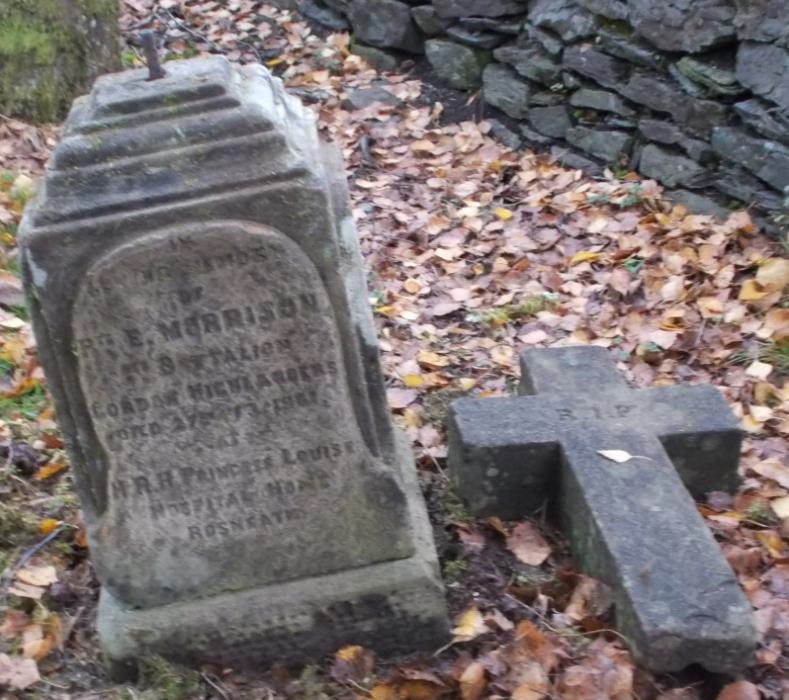
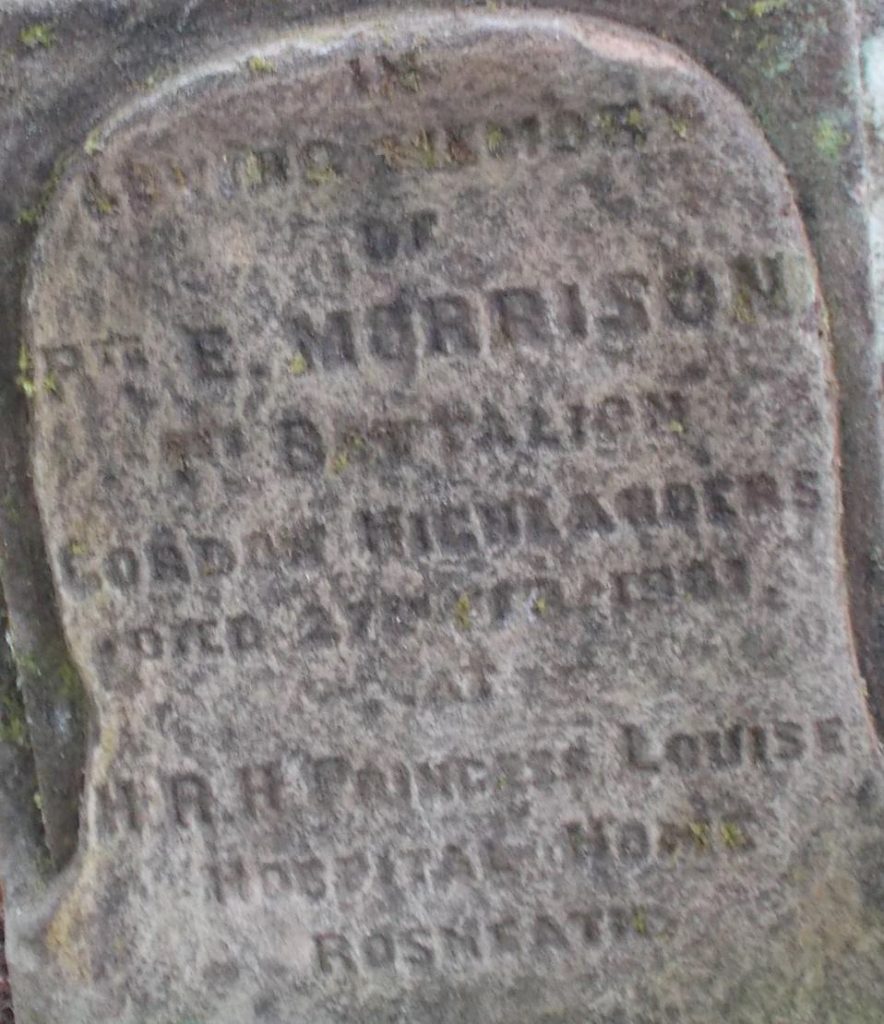
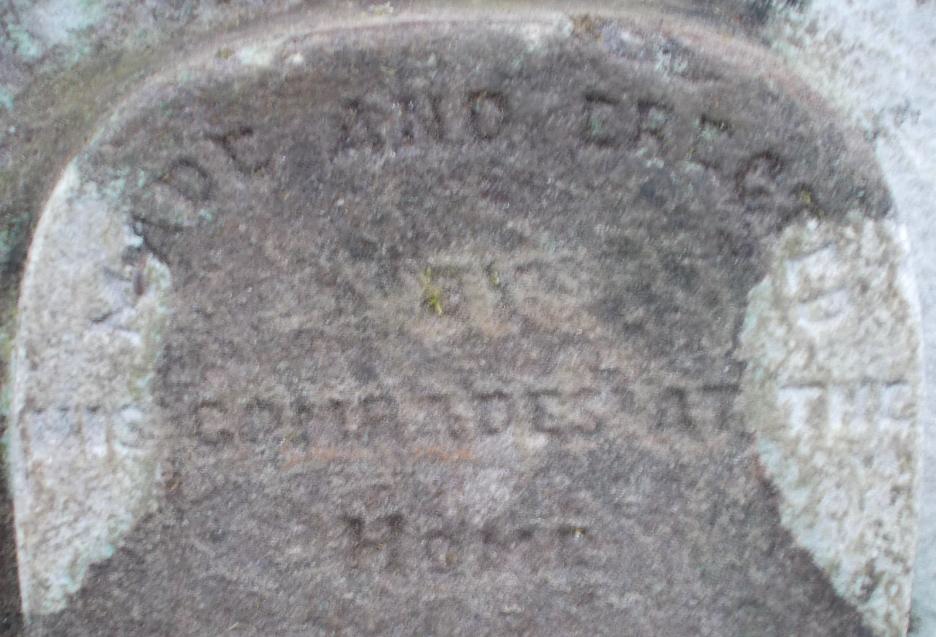
INSCRIPTIONS
East side
R.I.P.
PTE. E. MORRISON HOME
1ST. BATTALION
GORDON HIGHLANDERS
DIED 27TH. FEB. 1901
AT
H.R.H. PRINCESS LOUISE
HOSPITAL HOME
ROSNEATH
North side
MADE AND ERECTED
IN LOVING MEMORY BY
OF HIS COMRADES AT THE
HOME
Smith Family Information from Statutory Registers.
!852 / 3 – Marriage of Edward Smith and Mary Morrison was before Statutory Registers of marriage started in 1855.
!858 – Birth of daughter (and sister) Mary:-

District of Milton, Glasgow.
Name – Smith, Mary.
When and where – 1858, January 6th. at 10, Well Road, Springbank, Glasgow.
Father – Edward Smith, General Labourer.
Mother – Mary Smith, maiden surname Morrison.
1861 – Census, on 7th. April, returns for Edward Smith, Mary Smith and daughter Mary:-

Parish of St. George, Glasgow.
House – 361, Garscube Road.
Names – Edward Smith, age 31, Ag. labourer. Born Ireland.
Mary Smith, age 28. Born Linlithgow.
Mary Smith, age 3. Born Glasgow.
1861 – Birth of son Edward Smith:-

District of Milton, Glasgow.
Name – Edward Smith.
When and where – 1861, September 8th. at 361, Garscube Road, Glasgow.
Father – Edward Smith, labourer.
Mother – Mary Smith, maiden surname Morrison.
Married – 1852 July, Glasgow.
1866 – Death of father Edward:-

District of Maryhill, County of Lanark.
Name – Edward Smith, general labourer, married to Mary Morrison.
When and where – 1866, July 28th. at Lindsays Land, —-vale ?, Maryhill Parish, age 35.
Father – John Smith, Brewer, (deceased).
Mother – Betsy Smith, maiden surname Cunningham (deceased).
Cause – Fever.
1866 – Birth of son (and brother) Charles:-

Central District, Glasgow.
Name – Charles Smith.
When and where – 1866, September 20th. at City Poorhouse,* Glasgow.
Father – Edward Smith, Labourer, deceased.
Mother – Mary Smith, maiden surname Morrison.
Married – 1853, Glasgow. (On register of birth of son Edward it has 1852).
Informant – John M’Pherson, Session Clerk.
* With his father dying 2 months previously, times for the family must have been hard.
The City Poorhouse was relocated to what was the Glasgow Asylum building in 1845. It offered food and shelter for those with nowhere else to go. Living conditions were maintained at a level to discourage all but the most desperate. Anyone with living family was expected to seek their support first. Males and females were separated and children separated from their parents. Later reports mention poor sanitation and overcrowding.
1871 – Census, on 2nd. April, returns for mother Mary, daughter Mary and sons Edward and Charles
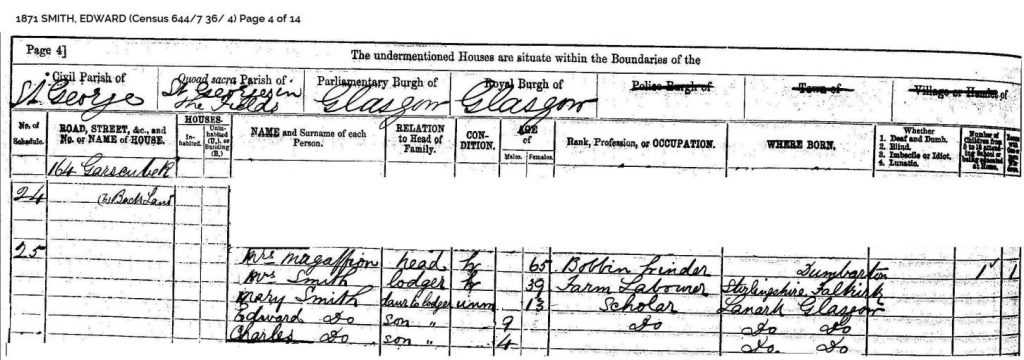
Parish of Sr. George’s in the Fields, Glasgow.
House – 164, Garscube Road, (b) Backland. (There was also an (a) Backland).
Names – Mrs. Smith, lodger, age 39, farm labourer, born Falkirk. (previously Kirkintillock quoted in 1861).
Mary Smith, daughter, unmarried, age 13, scholar, born Glasgow.
Edward Smith, son, age 9, scholar, born Glasgow.
Charles Smith, son, age 4, born Glasgow.
1881 – Census, on 3rd. April, returns for mother Mary, sons Edward and Charles and daughter Mary:-

Parish of St. George’s in the Fields, Glasgow.
House – 5, Oakbank Street.
Names – Mary Smith, Widow, age 52. Occ. (Annuitant)*. Born Glasgow (ditto marks from line above).
Edward Smith, Son, unmarried, age 19, Caster, Born Glasgow.
Charles Smith, Son, age 15, Scholar, Born Glasgow.
Mary Smith, Daughter, Unmarried, age 22, Cotton Weaver. Born Glasgow.
*’Annuitant’ – Someone who is entitled to collect the regular payments of a pension.
1891 – Census, on 5th. April, returns for mother Mary and daughter Mary

City Parish of Glasgow – St. George.
House – 19, Kelvin Street.
Names – Mary Smith, head, widow, age 60, formerly Cotton Mill worker, born Glasgow.
Mary Smith, Daughter, unmarried, age 32, Cotton Mill worker, born Glasgow.
1901 – Death of Edward Morrison Smith at Rosneath:-
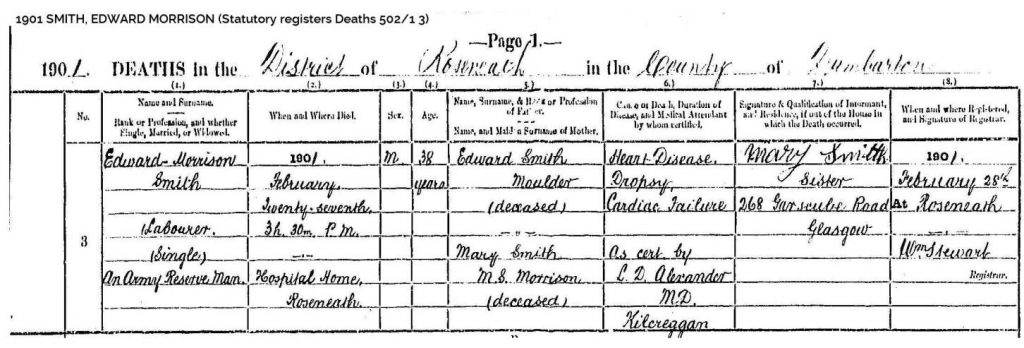
District of Rosneath, County of Dumbarton.
Name – Edward Morrison Smith, Labourer, (single), An Army Reserve Man.
When and where – 1901, February 27th. at 3:30 p.m., Hospital Home, Rosneath, age 38.*
Father – Edward Smith, moulder, (deceased).
Mother – Mary Smith, maiden surname Morrison (deceased).
Cause – Heart disease, Dropsy, Cardiac Failure.
Informant – Mary Smith, Sister, 268, Garscube Road, Glasgow.
* He was born on 8th. September 1861 so would have been aged 39 years.
In the above records the family was at 6 different addresses between 1858 and 1891 (not counting the period in the City Poorhouse). Life was not easy for the Smith family.
I have not been able to trace the sons Edward and Charles after the 1881 census. Perhaps at 19 years, or soon after, Edward chose to enlist. If he did so it would explain his ‘Army Reserve’ status quoted in the register entry of his death.
Concerning Edward’s birth in Glasgow and the newspaper reports from the Dundee Evening Telegraph and the Lennox Herald:-
Recruitment of a Glasgow man was generally into the Highland Light Infantry while a Dundee area man was generally into the Black Watch and a Lennox man into the Argyll and Sutherland Highlanders.
Perhaps his serving in the Gordon Highlanders (general recruiting area of Aberdeenshire) was just a case of being sent to a unit needing a re-enforcement.
Until some more information is found it remains a bit of a puzzle. If you are able to provide more information on Edward Morrison (Smith) please advise and we will include.
1878 – 1879 Anglo-Zulu War
John Clarke.
Lieutenant – 7th. Field Company, Royal Engineers.
Date of death – 11th. June 1879.
Age – 24.
Memorial – Royal Engineers Memorial, Rochester Cathedral and on his father’s grave stone in Rosneath old churchyard.
His grave is in Fort Napier Military Cemetery, Pietermaritzburg, South Africa.
Youngest son of William Nelson and Mary Leslie Clarke (nee Lendrum), late of Barremman House, Clynder. Born on 18th. June 1855 at Balwharrie, Crieff, Parish of Muthill, Perthshire.
John Clarke died of disease at Pietermaritzburg.
The 7th. Field Company was the resident Royal Engineer unit in South Africa at the time of the 1878 – 1879 Anglo Zulu War. They had arrived at the Cape of Good Hope in 1876.
Two more Field Companies of Engineers (the 2nd. and the 5th.) embarked for South Africa on 2nd. December 1878 and landed at Durban on 4th. January 1879 for the reinforcement of the Corps in South Africa, which had previously only consisted of the 7th. Company commanded by Major F. W. Nixon, who had under him Lieutenants F. H. MacDowell and John Clarke.
The 2nd. and 5th. Field Company (with Lieutenant J. R. M. Chard who was to be awarded the V.C. at Rorke’s Drift) were with the columns that crossed into Zululand on 11th. January 1879.
Lieutenant F. H. MacDowell from the 7th. Company was attached to the 5th. Company. He was killed at Isandhlwana on the 22nd. January.
Report from The Glasgow Herald of 18th. July 1879.
CLARKE – On the 11th. June at Pietermaritzburg, Natal, John Clarke, Lieutenant, Royal Engineers, younger son of the late William Nelson Clarke, Esq., formerly of Ardington Berkshire, aged 24.
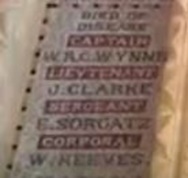
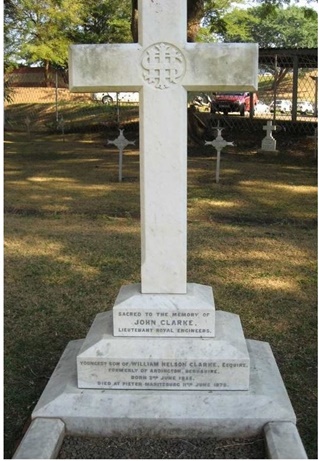
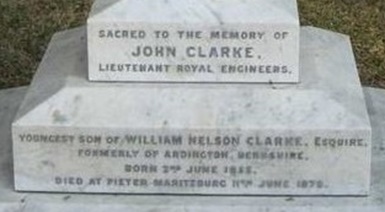
William Nelson Clarke
(John Clarke’s Father)
William Nelson Clarke was a Doctor of Civil Law and proprietor of stock funds, was the last Lord of the Manor of Ardington, Berkshire (he sold it in 1833).
He married Catherine Molyneux, daughter of Lt. – Gen. Sir Thomas Molyneux, 5th. Baronet Molyneux of Castle Dillon, co. Armagh, on 22nd. February 1827. They had five children (Maria Elizabeth Molyneux Clarke; Somerset Molyneux Clarke; Emily Sarah Molyneux Clarke; Kenmure Stuart Molyneux Clarke and Catherine Molyneux Clarke). Catherine, his wife, died on 10th. October 1840.
Circa 1843 he was in residence at Banskeld House, Pitlochry.
He married Mary Leslie Lendrum on 23rd. June 1844 at Muthill, Crieff. They had five children (Edward Temple Clarke {possibly died in infancy as no further trace}, Mary Emily MacKenzie Clarke, Esther Temple Nelson Clarke, Alice Nelson Clarke and John Clarke). The family was at Balwharrie, just East of Crieff, in the Parish of Muthill. The four children were all born in the Parish of Muthill.
In the 1851 census (30th. March) the Family was at Barremman House, Clynder. His daughter Emily Sarah died there on 24th. December 1851, aged 18 years.
William Nelson Clarke died at 5, North Charlotte Street, Edinburgh on 10th. November 1855, aged 56 years.
In the 1861 census his widow and the three youngest children (Esther, Alice and John) are at Murrayfield Cottage, Crieff.
Grave of William Nelson Clarke in Rosneath old churchyard.
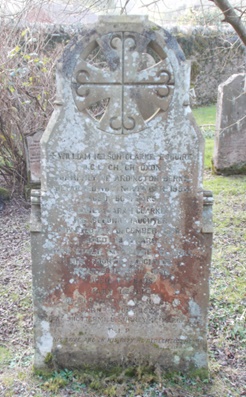
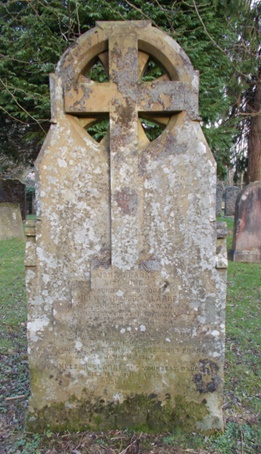
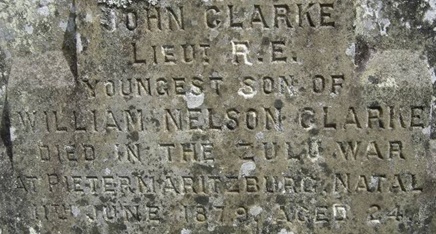
Wording on William Nelson Clarke’s grave stone.
Front (East) face of stone –
+ WILLIAM NELSON CLARKE ESQUIRE
D.C.L. CH. CH. OXON.
FORMERLY OF ARDINGTON BERKS.
DEPARTED 10TH. NOVEMBER 1855.
AGE 56 YEARS.
EMILY SARAH CLARKE
HIS SECOND DAUGHTER
DEPARTED 24TH. DECEMBER 1850
AGED 18 YEARS.
MARY EMILY McKENZIE CLARKE
HIS FOURTH DAUGHTER
DEPARTED 1ST. APRIL 1860
AGED 11 YEARS.
MARY LESLIE
WIFE OF THE ABOVE W. N. CLARKE
BORN 1ST. JUNE 1816.
DIED AT SHOTTERMILL, SURREY, 4TH. MARCH 1905
R.I.P.
Rear (West) face of stone –
JOHN CLARKE
LIEUT. R.E.
YOUNGEST SON OF
WILLIAM NELSON CLARKE
DIED IN THE ZULU WAR
AT PIETERMARITZBURG, NATAL
11TH. JUNE 1879 AGED 24.
ESTHER TEMPLE NELSON CLARKE
THE FIFTH DAUGHTER
BORN 20TH. MAY 1850, DIED AT ARCACHON FRANCE
1ST. JANUARY 1927
ALICE NELSON CLARKE THE YOUNGEST DAUGHTER
DIED 18TH. JULY 1933
JESU MERCY
1884 – 1885 Mahdist (Sudanese) War
Lieut. J. B. Richardson.
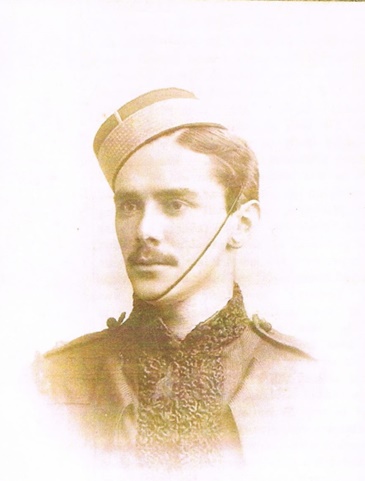
Report from the Glasgow Herald of 25th. March 1885.
In one of the despatches from Suakim it is stated that “Richardson of the 5th. Lancers is missing – the worst is feared.” Mr. Richardson only recently joined the Lancers, and holds the rank of lieutenant. He is the only son of Mr. David Richardson, Glasgow.
Report from the Glasgow Herald of 26th. March 1885.
LIEUTENANT J. B. RICHARDSON.
The General in command at Suakim telegraphs that Lieutenant Richardson of the 5th. Lancers is missing. Lieut. J. B. Richardson, eldest son of Mr. David Richardson of Hartfield (senior partner of Messrs. James Richardson & Co., sugar refiners, Greenock), was born in June, 1861, and was educated at Elstree and Harrow, whence he went to University College, Oxford. From this he passed into Sandhurst, heading the list of university candidates, and obtained his commission in the 5th. Lancers in March, 1883. With the view of being useful in his profession he devoted himself to the study of modern languages – especially Russian, which he could speak and write fluently.
Report from the Glasgow Herald of 6th. April 1885.
RELICS OF LIEUTENANT RICHARDSON.
(DAILY TELEGRAPH TELEGRAM.)
Suakim, April 3, 10 p.m.
The saddle and whistle of Lieutenant Richardson, of the 5th. Lancers, who with a corporal and two men has been missing ever since the fight of the 22d ult., were found today by a cavalry scout.
Apparently, Lieutenant Richardson and the others were cut off and killed by a body of the enemy’s camelry.
Report from the Helensburgh and Gareloch Times of 8th. April 1885.
THE LATE LIEUTENANT RICHARDSON – We regret to state that the latest tidings relative to the disappearance of this promising young officer are of such a nature as to leave no doubt in the minds of his many friends that he has met his death at the hands of the Arabs, The incident, it will be remembered, which led to his disappearance was the occasion of the Sunday surprise near Tamai, where our troops suffered somewhat severely. A Daily Telegraph Suakim correspondent of April 3rd says – “The saddle and whistle of Lieut. Richardson, of the 5th Lancers, who with a corporal and two men has been missing ever since the fight of the 22nd ult., were found to-day by a cavalry scout.” On Sunday last, the Rev. J. Stevenson of Kilcreggan, made a touching reference to the sudden disappearance of the late young officer, who was a member of his congregation. Lieut. Richardson was a native of Kilcreggan*, and was widely known and greatly respected. Much sympathy is felt for the relatives, and a feeling of gloom rests on the neighbourhood in consequence of the uncertainty of his fate.
*He was born on 2nd. June 1861 at 9 Park Terrace, Anderston, Glasgow.
Report from the Glasgow Herald of 10th. April 1885.
LIEUTENANT RICHARDSON’S FATE.
It is officially stated that since the reports of casualties in the engagement near Suakim on the 22d March were received, Sir G. Graham has reported Lieutenant Richardson, 5th. Lancers, as missing.
Report from the Helensburgh and Gareloch Times of 29th. April 1885.
THE LATE LIEUTENANT RICHARDSON – The saddle, knapsack, and baggage of this gallant young officer was landed at Kilcreggan Pier on Saturday last. It was afterwards taken to Hartfield, the residence of the family.
Report from the Helensburgh and Gareloch Times of 13th. May 1885.
THE LATE LIEUTENANT RICHARDSON – Amongst the list of illustrations in the Graphic of May 9th is an excellent picture of the late Lieutenant Richardson of Hartfield. Those of our readers desirous of possessing a memento of this gallant young officer will find this a favourable opportunity.
